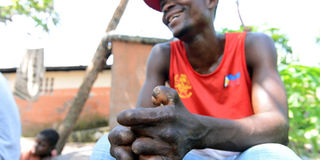Leprosy still prevalent

PHOTO | AFP A man suffering from Leprosy sits in a chair on January 25, 2013 in thegarden of the Hopital de la Rive in Kinshasa, Democratic Republic of Congo.
What you need to know:
- Leprosy is a condition caused by an infection with a bacterium called Mycobacterium leprae. It can affect various parts of the body, commonly the skin, nerves, eyes, lining of the nose and muscles . Often, it causes irreversible damage.
- Nerve damage, whereby one loses sensation in fingers, toes, hands, arms, feet and skin – causing disfigurement, including nodules
- Diagnosis is mostly from history and examination of affected areas, though a sample (smear or biopsy) of the skin can be taken for laboratory diagnosis.
Last year, the Tuberculosis, Leprosy and Lung Disease Unit of the Ministry of Health reported almost 140 cases. The actual number leprosy patients is expected to be much higher. And majority of those affected were aged 15-35 — mostly young people including children.
There remain pockets of leprosy in the country, such as Msambweni in Kwale, Kinango and Kaloleni in Kilifi, and parts of Kitui, Busia, and Kisumu counties. There may be other pockets with undiagnosed leprosy.
So what is leprosy?
Leprosy is a condition caused by an infection with a bacterium called Mycobacterium leprae. It can affect various parts of the body, commonly the skin, nerves, eyes, lining of the nose and muscles . Often, it causes irreversible damage.
How does it spread and who is at risk of getting leprosy?
Leprosy spreads through contact with droplets from the mouth and nose of an infected and infectious person. Leprosy is not very contagious. It is spread mostly by patients with the infectious variety, referred to as the multi-bacillary type.
Most people (95 per cent) are naturally immune to leprosy.
In those who develop the disease, progression from infection to leprosy symptoms is slow and can take from three to 20 years!
While anyone can get leprosy, those at risk of infection are people in close contact with infectious persons, including those who are infected but yet to be diagnosed. Other risk factors are poor water and sanitation, and poor beddings. Children are at higher risk.
SYMPTOMS
In early infection, one may experience the following:
Light patches on the skin
Numbness on affected skin patches
Loss of hair on affected patches.
Sadly, many of the symptoms occur once the disease has remained untreated for long, and include:
Nerve damage, whereby one loses sensation in fingers, toes, hands, arms, feet and skin – causing disfigurement, including nodules
Shrinkage of toes or fingers. This occurs after loss of sensation. They don’t fall off as is commonly believed.
DIAGNOSIS
Diagnosis is mostly from history and examination of affected areas, though a sample (smear or biopsy) of the skin can be taken for laboratory diagnosis.
Unfortunately, many health care workers do not suspect leprosy and therefore fail to order the tests until it is too late.
How is it treated?
Treatment is available and involves taking specific drugs for a period of 6-12 months depending on the disease.
Your doctor will advise and monitor you until you are cured. Fortunately, these medicines and the whole course of treatment, including tests, are available for free at public hospitals.
After about two weeks of effective treatment, one is no longer infectious.
How about family members?
As leprosy is contagious. If you are diagnosed with it, your family members will need to be examined to see if they too have the disease. Those who are not infected will not need to take medication.
COMPLICATIONS
If leprosy goes untreated, one may develop complications including disfigurement, muscle weakness, permanent nerve damage in the limbs, sensory loss, erectile dysfunction and infertility in men, blindness, kidney failure and permanent damage to the nose.
The writer is a doctor and public health specialist. Send your questions to [email protected]




